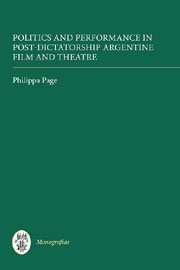Book contents
- Frontmatter
- Contents
- List of Illustrations
- Dedication
- Acknowledgements
- Introduction
- ‘Theatre[s] of Cruelty’ and Politics of Performance in the Work of ‘Teatrista’ Eduardo Pavlovsky and Filmmaker Fernando E. Solanas
- De-mythifying the Postmodern ‘Opium of the People’: Theatre and Cinema versus Television
- ‘Metáforas del Fracaso’ or ‘a Family Romance’? Resuscitating Aesthetic Lineages
- Biodramas/Biography/Biopolitics:Projects of ‘Convivencia’ in New Argentine Cinema and Theatre
- Conclusion
- Filmography
- Bibliography
- Index
‘Theatre[s] of Cruelty’ and Politics of Performance in the Work of ‘Teatrista’ Eduardo Pavlovsky and Filmmaker Fernando E. Solanas
Published online by Cambridge University Press: 05 February 2013
- Frontmatter
- Contents
- List of Illustrations
- Dedication
- Acknowledgements
- Introduction
- ‘Theatre[s] of Cruelty’ and Politics of Performance in the Work of ‘Teatrista’ Eduardo Pavlovsky and Filmmaker Fernando E. Solanas
- De-mythifying the Postmodern ‘Opium of the People’: Theatre and Cinema versus Television
- ‘Metáforas del Fracaso’ or ‘a Family Romance’? Resuscitating Aesthetic Lineages
- Biodramas/Biography/Biopolitics:Projects of ‘Convivencia’ in New Argentine Cinema and Theatre
- Conclusion
- Filmography
- Bibliography
- Index
Summary
Undoubtedly the most obvious point of comparison between theatre and cinema is to be located in their shared status as performance arts. It is these common codes of performance that cement the cinematic and theatrical hybrids that will be examined in this chapter. Richard Schechner's basic definition of performance was given in the Introduction as ‘an activity done by an individual or group in the presence of and for another individual or group’ (2003: 22). However, Schechner's positioning of film in relation to the performance continuum is somewhat ambiguous. Although in cinema the actors and audience are not in the direct presence of one another, I would suggest that there is still a convincing argument for defining cinema as a performance art. Whilst it cannot be denied that cinema is a medium, it remains a mediated performance, constituting a virtual presence. Cinema still involves the representation of an actor speaking and moving (although in front of the camera, rather than directly before a live audience). Jean-Paul Sartre makes the interesting observation that even if the actors in theatre are alive, in cinema they are closer to the audience (1992: 94). This, I would attribute to certain spectatorial conventions in cinema, developed in relation to the transparency of cinematic realism. One of the arguments that will be developed in this chapter is that cinema and theatre collaborate in order to establish praxis through this shared notion of performance. As Solanas' films engage in a politics of performance, what will be argued is that film's borrowing from theatre marks an attempt to compensate for its lack of direct presence.
- Type
- Chapter
- Information
- Politics and Performance in Post-Dictatorship Argentine , pp. 24 - 62Publisher: Boydell & BrewerPrint publication year: 2011



